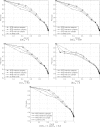Adaptive learning for relevance feedback: application to digital mammography
- PMID: 20879602
- PMCID: PMC2927692
- DOI: 10.1118/1.3460839
Adaptive learning for relevance feedback: application to digital mammography
Abstract
Purpose: With the rapid growing volume of images in medical databases, development of efficient image retrieval systems to retrieve relevant or similar images to a query image has become an active research area. Despite many efforts to improve the performance of techniques for accurate image retrieval, its success in biomedicine thus far has been quite limited. This article presents an adaptive content-based image retrieval (CBIR) system for improving the performance of image retrieval in mammographic databases.
Methods: In this work, the authors propose a new relevance feedback approach based on incremental learning with support vector machine (SVM) regression. Also, the authors present a new local perturbation method to further improve the performance of the proposed relevance feedback system. The approaches enable efficient online learning by adapting the current trained model to changes prompted by the user's relevance feedback, avoiding the burden of retraining the CBIR system. To demonstrate the proposed image retrieval system, the authors used two mammogram data sets: A set of 76 mammograms scored based on geometrical similarity and a larger set of 200 mammograms scored by expert radiologists based on pathological findings.
Results: The experimental results show that the proposed relevance feedback strategy improves the retrieval precision for both data sets while achieving high efficiency compared to offline SVM. For the data set of 200 mammograms, the authors obtained an average precision of 0.48 and an area under the precision-recall curve of 0.79. In addition, using the same database, the authors achieved a high pathology matching rate greater than 80% between the query and the top retrieved images after relevance feedback.
Conclusions: Using mammographic databases, the results demonstrate that the proposed approach is more accurate than the model without using relevance feedback not only in image retrieval but also in pathology matching while maintaining its effectiveness for online relevance feedback applications.
Figures












Similar articles
-
A similarity learning approach to content-based image retrieval: application to digital mammography.IEEE Trans Med Imaging. 2004 Oct;23(10):1233-44. doi: 10.1109/TMI.2004.834601. IEEE Trans Med Imaging. 2004. PMID: 15493691 Clinical Trial.
-
Relevance feedback for enhancing content based image retrieval and automatic prediction of semantic image features: Application to bone tumor radiographs.J Biomed Inform. 2018 Aug;84:123-135. doi: 10.1016/j.jbi.2018.07.002. Epub 2018 Jul 5. J Biomed Inform. 2018. PMID: 29981490
-
Using relevance feedback to reduce the semantic gap in content-based image retrieval of mammographic masses.Annu Int Conf IEEE Eng Med Biol Soc. 2008;2008:406-9. doi: 10.1109/IEMBS.2008.4649176. Annu Int Conf IEEE Eng Med Biol Soc. 2008. PMID: 19162679
-
Optimal query-based relevance feedback in medical image retrieval using score fusion-based classification.J Digit Imaging. 2015 Apr;28(2):160-78. doi: 10.1007/s10278-014-9730-z. J Digit Imaging. 2015. PMID: 25246167 Free PMC article. Review.
-
Content-based image retrieval in radiology: current status and future directions.J Digit Imaging. 2011 Apr;24(2):208-22. doi: 10.1007/s10278-010-9290-9. J Digit Imaging. 2011. PMID: 20376525 Free PMC article. Review.
Cited by
-
A novel similarity learning method via relative comparison for content-based medical image retrieval.J Digit Imaging. 2013 Oct;26(5):850-65. doi: 10.1007/s10278-013-9591-x. J Digit Imaging. 2013. PMID: 23563792 Free PMC article.
-
Artificial Intelligence: reshaping the practice of radiological sciences in the 21st century.Br J Radiol. 2020 Feb 1;93(1106):20190855. doi: 10.1259/bjr.20190855. Br J Radiol. 2020. PMID: 31965813 Free PMC article. Review.
-
Breast Cancer Segmentation Methods: Current Status and Future Potentials.Biomed Res Int. 2021 Jul 20;2021:9962109. doi: 10.1155/2021/9962109. eCollection 2021. Biomed Res Int. 2021. PMID: 34337066 Free PMC article. Review.
-
Automatic medical image annotation and keyword-based image retrieval using relevance feedback.J Digit Imaging. 2012 Aug;25(4):454-65. doi: 10.1007/s10278-011-9443-5. J Digit Imaging. 2012. PMID: 22193754 Free PMC article. Review.
-
Overview on subjective similarity of images for content-based medical image retrieval.Radiol Phys Technol. 2018 Jun;11(2):109-124. doi: 10.1007/s12194-018-0461-6. Epub 2018 May 8. Radiol Phys Technol. 2018. PMID: 29740749 Review.
References
-
- Bimbo A. D., Visual Information Retrieval (Morgan Kauffman, San Francisco, 1999).
-
- Rui Y. and Huang T., “Image retrieval: Current techniques, promising directions and open issues,” J. Visual Commun. Image Represent JVCRE7 10, 39–62 (1999).10.1006/jvci.1999.0413 - DOI
-
- Zhou X. S. and Huang T. S., “Relevance feedback in image retrieval: A comprehensive reviews,” Multimedia Syst. ZZZZZZ 8, 536–544 (2003).10.1007/s00530-002-0070-3 - DOI
-
- Tao D., Li X., and Maybank S. J., “Negative samples analysis in relevance feedback,” IEEE Trans. Knowl. Data Eng. ITKEEH 19(4), 568–580 (2007).10.1109/TKDE.2007.1003 - DOI
-
- Baeza-Yates R. and Ribeiro-Neto B., Modern Information Retrieval (Addison-Wesley Longman Publishing Co., Inc., Boston, 1999).
Publication types
MeSH terms
Grants and funding
LinkOut - more resources
Full Text Sources
Medical

